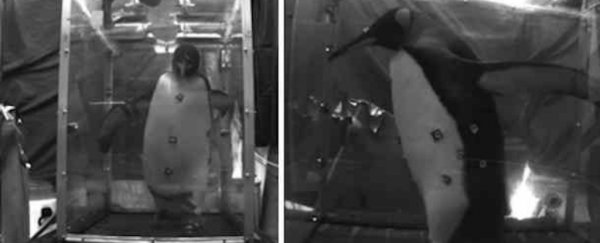What an incredible world we live in, where you can put chubby king penguins on a treadmill and monitor how many times they fall over, all in the name of science.
To be clear, no penguins were harmed in this research, and it was done for a good cause - to better understand the trade-off between body weight and agility. That trade-off is crucial for penguins, because they need to stack on the weight so they can survive for weeks without food while raising their young, but can't get so fat that they're unable to escape from predators.
As important as that is, you can't deny that the experiment had the side effect of just being adorable to watch (note: the video has been sped up).
These rotund king penguins are serial monogamists, and both sexes stack on weight each year so they can spend several weeks out of the ocean guarding their single egg on land. Once it hatches, they then spend another month or so sheltering their chick between their feet and stomach, while taking turns to eat.
All in all, the birds can fast for up to a month at a time while rearing their young, which is why that excess weight is so important. But a team of researchers led by Astrid Willener from the University of London wanted to see whether it also affected their gait.
To figure this out, Willener's team captured 10 male king penguins from Antarctica that weighed more than 12 kg, and put them in a pen next to their colony where they'd set up a little treadmill.
The penguins didn't eat throughout the 14-day experiment so the team could see how weight loss would affect their gait. That sounds cruel, but it's something the animals are equipped for, and they were closely monitored to make sure they were staying healthy during the experiment.
That isn't to say the experiment was all smooth-sailing. "A good amount of the individuals were able to walk on a treadmill straight away," Willener told The Guardian. "But an individual that is not able to walk straight away on a treadmill is difficult to train."
"Sometimes the penguins were lazy and 'water-skied' on the treadmill by leaning their back on the back wall of the treadmill. That is obviously not good for the data collection," she added.
Once they'd sorted that out, the researchers set the treadmill to a cruisy speed of 1.4 km/h and monitored the penguin's walking skills throughout the two-week period - this was done by calculating the amplitude of peak left and right leaning.
The results showed that the penguins had adjusted their waddling speed to keep up with the treadmill, even at their peak weight. But they fell over more when they were fatter, and were slightly less agile.
"Waddling amplitude, leaning amplitude and leaning angle all remained fairly constant across the two body masses," the researchers report in PLOS One.
"However, some differences were uncovered; in particular there was good evidence that variability in the leaning angle and leaning amplitude, and some evidence that the waddling amplitude, were lower when the birds were lighter," they add. "These results indicate that heavier king penguins have a higher frontal and sagittal instability; they are less stable walkers than when they are lighter."
That doesn't matter so much most of the year, when swimming is their primary mode of getting around ("being agile in the water was more important that a quick and graceful gait," Willener admitted), but it could have a big impact when they're land-bound during the breeding season.
 Yvon Le Maho et al. Nature Methods
Yvon Le Maho et al. Nature Methods
After the experiment, the brave science penguins were returned to their colony.
It's not the only time the animals have been utterly adorable in the name of research - who can forget this tiny penguin robot (above) sent in to spy on colonies and learn their secrets?
But while it's cute on the surface, this type of research could be crucial to helping us protect penguins - and with 150,000 of the birds dying at once just a few weeks ago, that's more important than ever.
In future, identifying the right balance between how much penguins need to eat to be able to properly rear their young, and how light they need to stay to escape predation on land, could be the key to managing populations. "The link between gait and energy expenditure can help to improve penguin protection," said Willener.
Stay strong, penguins, science has your back.

